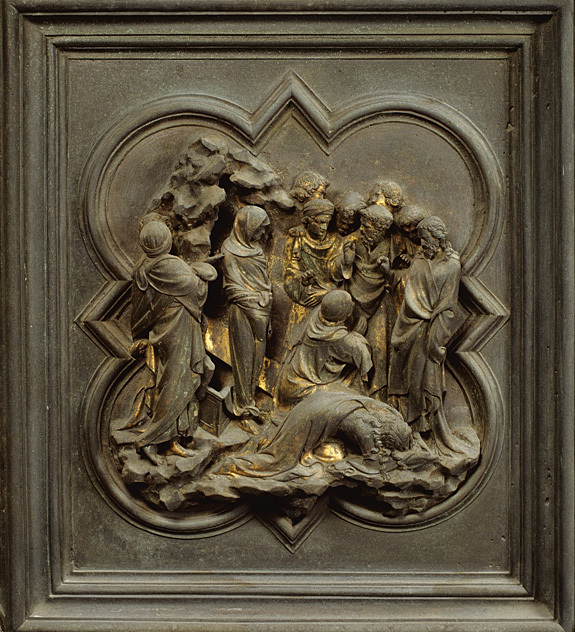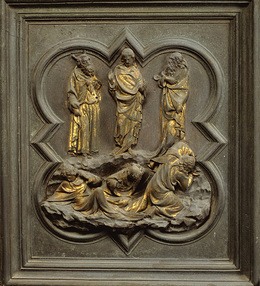Panel X - The Raising of Lazarus
Panel details:
John 11.1 to 53: “Lazarus, come forth!”
Lazarus was resurrected in the town of Bethany, which is located on the eastern slopes of mount of olives, 3 kilometres from Jerusalem.
Bethany and the nearby town of Bethphage were the last rest stops for travellers journeying to the city of Jericho.
In ancient times Bethany was only a small village, although it was quite well known. It is quoted in the sacred scriptures with the name Ananias as one of the places the benjaminites repopulated on their return from Babylon.
The episode of the resurrection of Lazarus is narrated in the gospel of John.
The episode is presented as one of the greatest miracles Jesus performed and is directly connected to the resurrection of Christ. it is the last of the signs that Jesus performed before the passion, as the next sign would be his own resurrection
The evangelist narrates that when Jesus received a message from Lazarus’ sisters Martha and Mary, informing him that their brother was ill, he was not in Judea.
Jesus did not want to leave immediately for Bethany, where Lazarus lived, and he stayed two more days where he was. When finally after two days he was ready to leave, he told his disciples that Lazarus was dead and that he would reawaken him, and started his journey to Bethany. When Jesus arrived in Bethany, Lazarus had been dead for four days. The gospel makes this clarification presumably because jews believed that the decomposition of the body began the third day after death, and the purpose of this was to dispel any doubt of a possible apparent death. It can be assumed that Jesus purposely delayed the trip because of this belief. Jesus met first with Martha outside the village. During their brief conversation, Jesus announced that Lazarus would rise again and added, “...i am the resurrection and the life; ...whoever believes in me, though he were dead, yet shall he live...;” “whosoever liveth and believeth in me shall never die...” (John 11,25-26). Martha immediately called Mary, who threw herself at Jesus’ feet and wept. Jesus was moved and wept in turn. Then he went to the tomb and ordered the stone that closed the entrance to the tomb be removed. as soon as the stone was removed, Jesus thanked god out loud, so everyone present could hear him, and then shouted, “Lazarus, come forth!“ (John 11-43). Lazarus came out of the tomb, still wrapped in the funeral bandages and Jesus ordered the strings be removed and Lazarus freed. The gospel continues with two episodes closely linked to this one. In the first (John 11,45-53) the chief priests and pharisees, informed of the incident, called a council, and decided to kill Jesus, following the advice of Caiaphas, who pronounced the famous phrase: “...better that one man should die for the people” (John 11,50). In the second episode (John 12.1 to 11), a few days later, Jesus was having dinner with Lazarus, and many people flocked to see them. Then the chief priests, seeing that many believed in Jesus because of Lazarus, decided to kill Lazarus, too. Martha, Mary and Lazarus, the three siblings who lived in Bethany, were friends of Jesus even though we do not know the origin of their relationship with the lord. We know they were very close and affectionate to
each other. Martha, Mary and Lazarus invited Jesus to their home many times, especially during the days that preceded the passion, from Palm Sunday to the capture of Jesus. That week, Jesus walked the short distance back and forth from Bethany to Jerusalem to the mount of olives. In the evening, upon his return, he would relax surrounded by his friends and disciples, as narrated in the gospels (John 12, 2-8; cfr. Matthew 26: 6-13 and Mark 14: 3-9). The tomb of Lazarus has captivated the devotion of the faithful from the earliest days of Christianity. In the fourth century a sanctuary was built around it. the byzantine name, “to lazarion”, no doubt inspired the arab name of Bethany: al-azariye.
there is, however, no longer any trace of the house. In Bethany one contemplates Christ’s feelings of affection, revealing the infinite love of his father for everyone, and also Martha and Mary’s faith in his power to restore health.
The miracle of the resurrection of Lazarus, like other miracles Jesus performed, has a meaning that goes beyond the mere manifestation of the resurrection from death of the flesh. It indicates and exhorts the resurrection of the spirit. This is the new element. Jesus does not resurrect the dead, rather he communicates to the living that there is life that overcomes the threshold of death. This is why paul writes: “we who are already resurrected” (cfr. eph. 2,6), because eternal life is not a reward in the future, it is a condition in the present: “whoever lives and believes in me will have a quality of life that will not experience of death”.
The episode of the resurrection of Lazarus has always been a moment of great emotion and has had a strong hold on the faithful. There have been innumerable representations in the arts over the centuries since the beginning of Christianity. Some of the first representations of the miracle in the catacombs have been found as early as the fourth century. In these versions the oldest of the iconographic artistic language conveys the idea of eternity and the eternity of the divine in which Christ is portrayed as god eternally young and beardless, holding the cane of the saviour-miracle worker. The element of the cane was from ancient pagan heritage, representing a magic wand, as well as one of the god hermes’ attributes. This iconography was later abandoned for obvious theological reasons (Jesus did not need magical attributes to perform miracles). It served the purpose of emphasizing and making the miraculous event comprehensible to the people at that time.



